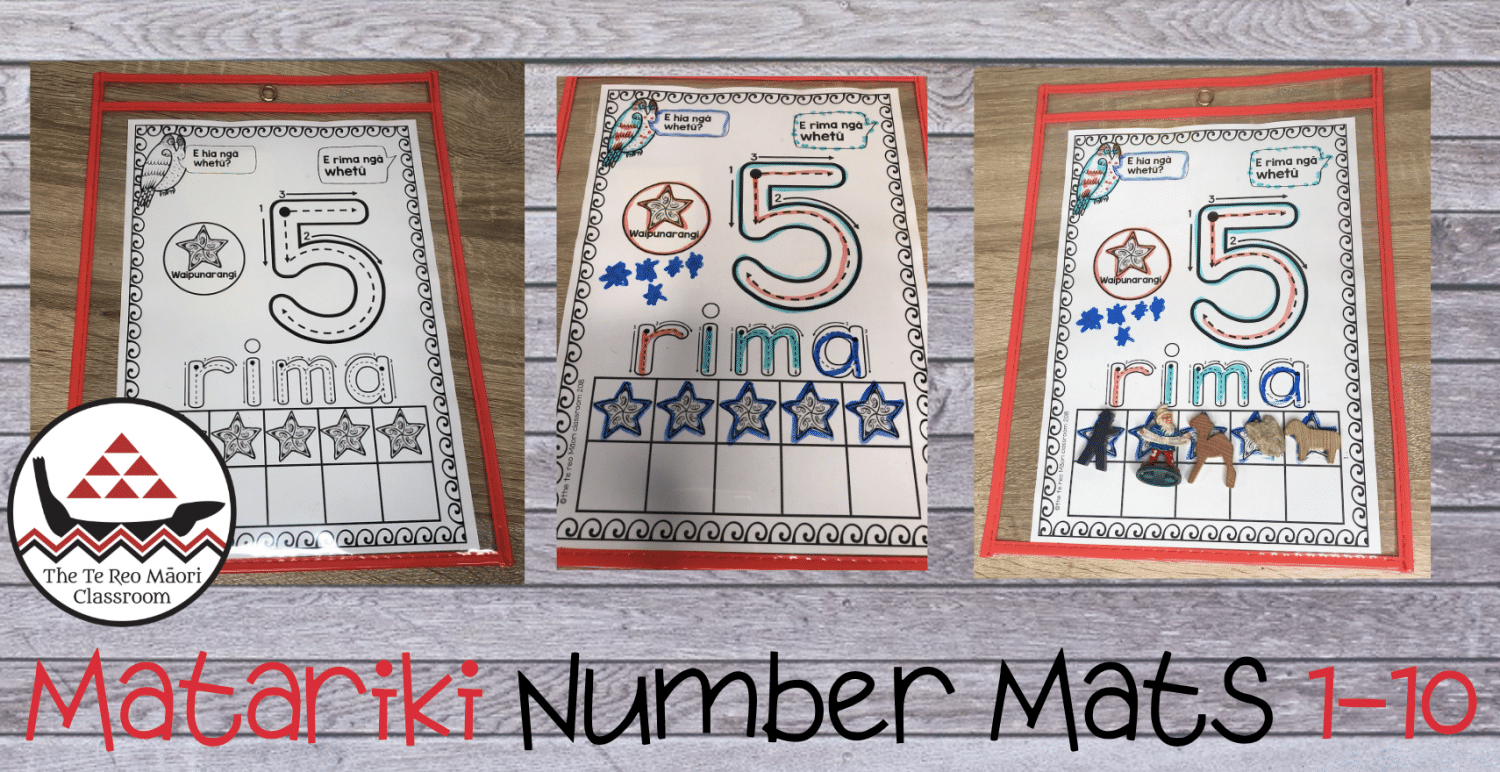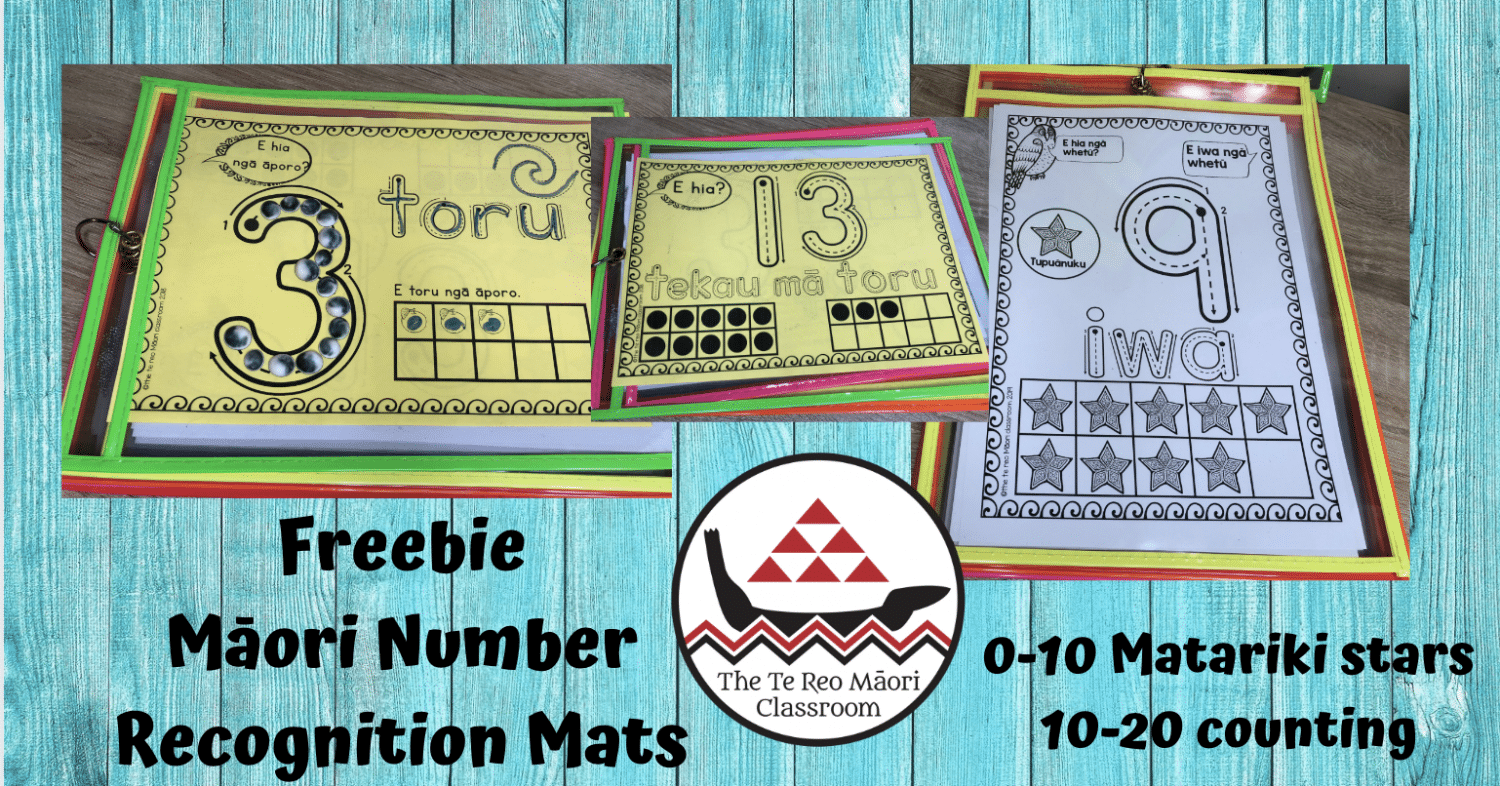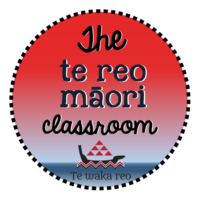Counting in te reo Māori is here. These Maori number recognition activity mats, paired with dry erase pockets, will surely get your tamariki counting the stars and learning numbers in te reo at the same time.
These Matariki number recognition mats for counting, feature tracing guides for numbers, number words and counting grids. Moreover, there are cues for asking and answering questions about numbers. Your tamariki will learn how to ask questions (e.g. “How many stars?” or “E hia ngā whetū?” in Māori ) and answer them as well. They are a great whānau activity for home.
I have also integrated the nine (9) stars of Matariki in this resource. The appearance of these stars are celebrated as the beginning of a new year. It’s also a good time for your ākonga to start learning how to count! ( especially to nine 🙂
Many of you are assisting with that in your whare!

Maths Achievement Objective
These are the expectations for level one of the Maths Curriculum.
- Count a set of objects in the range 1–10.
- Form a set of objects in the range 1–10.
- Identify all of the numbers in the range 1–10.
Maori Number Recognition
Counting and number recognition worksheets are among the first math worksheets that preschool and kindergarten children will practice with. Number recognition is a building block to success in maths. As Kōhanga, preschool and kindergarten children start to recognise their numbers, it is natural for them to begin counting objects.
Knowing your numbers is one thing and knowing how to count is another. On the other hand, being able to put them into a context that they each have meaning is done with one-to-one correspondence.
Gelman and Gallistel (1978) provided five principles that young students need to generalise when learning to count. The first three principles are:
- The one-to-one principle
Just like in reading when one spoken word is matched to one written word, counting involves one-to-one correspondence. One item in a collection is matched to one spoken or written word in the whole number counting sequence. - The stable order principle
The spoken and written names that are said and read have a fixed order. If that order is altered, e.g. “Tahi, rua, toru, whā,”, the count will not work. - The cardinal principle
Assuming the one-to-one and stable order principles are applied then the last number in a count tells how many items are in the whole collection. (E hia ngā mea?-How many things?)
Where to Start With Number
Learning to count usually starts with rote learning (learning the names of numbers off by heart). Tamariki often enjoy reciting or singing number songs without any understanding that each number represents groups of things.
Here’s the great number waiata by Anika Moa.
Children start learning to count by understanding the meaning of ‘one’ and ‘two’.
There are lots of opportunities to count with children in everyday life. Basically, your tamaiti may even be able to count — that is, say the numbers in the right order — 1-2-3-4-5 etc. However, it will take lots of experiences (practice, fun, games, talking and playing) before they actually understand that one refers to one object and 2 refers to 2 objects and so on.
The best thing whānau can do is to let their child learn by doing. Give them opportunities to play, sort and match objects, and give them ideas and language rather than trying to force them to actually count. Maths and ideas about numbers are everywhere.
Using Te Reo Number and Phrases
Keep it fun. Try counting steps, plates on the table, spoons by the plates, toothbrushes in the bathroom, dolls, toys, cars, fingers, arms and legs. Extend your reo by saying the māori kupu as well. E rua ngā pereti, e rua ngā naihi. (Two plates, two knives).
E hia ngā pereti? “Tahi, rua, toru”. E toru ngā pereti. (How many plates?, 1,2,3. Three plates.)
How many things? E hia ngā mea?
How many people? Tokohia ngā tangata?

How to Use Matariki Star Mats
- You can photocopy and laminate these mats. B U T, these activity mats are best paired with Dry Erase Pockets, if you want to re-use the activity.
- Count the number of stars-You can ask “E hia ngā whetū?” Tahi, rua…..
- Trace around the numeral-start at one.
- Look at the number word.
- Trace around the number word
- Find objects at home to put in the grids. Count as you place them.
- Tracing letters with loose parts is a tactile way for tamariki to explore letters, learn the alphabet and practice letter formation
“Early writing, often used synonymously with the term emergent writing, encompasses the following:
(a) the manual act of producing physical marks (i.e. mechanics),
(b) the meanings children attribute to these markings (i.e. composition), and
(c) understandings about how written language works (i.e. orthographic knowledge; Berninger, 2009). Although mechanics and composition are important features of early writing, we focus our attention on orthographic knowledge—how children’s marks reflect growing understandings of the writing system.
These understandings include both general conventions (e.g. print goes from left to right on a page) and understandings of specific features (e.g. speech can be represented by individual sounds, which can be written down using letters). Generally, we use the term early writing to refer to children’s representations of their knowledge about the writing system (i.e. orthographic knowledge).”
Your learner may not be ready to trace around the shapes yet. The brilliant thing with these Dry erase sheets is that they can do lots of wonderful scribbling. Or should I say fabulous drawing? (Making marks 🙂
More ideas on this stage of Maths, click here.
This blog post has additional information on Number Recognition.
GET YOUR FREEBIE Number Mats BELOW:
Dry Erase Pockets
Benefits
Firstly, you can insert pages in these pockets so that you can reuse them. Since they are heavy duty and durable, you can still use them with other worksheets. Furthermore, it’s cost-friendly and environmentally friendly. You don’t have to use a lot of paper and print many copies, allowing for mistakes without ruining the worksheet itself. They can simply erase it and have another go at it.
Uses
The pockets are clear on both sides, so you can insert templates or worksheets that are specific to the activity they need to work on. Teachers use these pockets with their class to help learners practice their weekly vocabulary words, spelling or maths. Using the dry erase pockets in a classroom setting will eliminate the task of creating multiple copies of worksheets, saving both time and photocopying allowance. Therefore, kaiako can reuse templates over and over since they stay clean and protected within the pocket. Also, parents can incorporate these tools into their child’s routine at home to help provide them with more ways to study. they clean really easily. You can use a tissue, wettex or an old piece of fabric to clean these off. Muku-cleaner.
I love the fact that you can do the same worksheet HEAPS of times. Users can easily erase any mistakes and continue working on the activity. I like the idea of using them for early finishing. In fact, I do them even though I know how to count.
Related Products:

